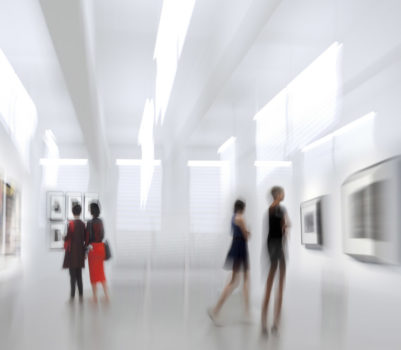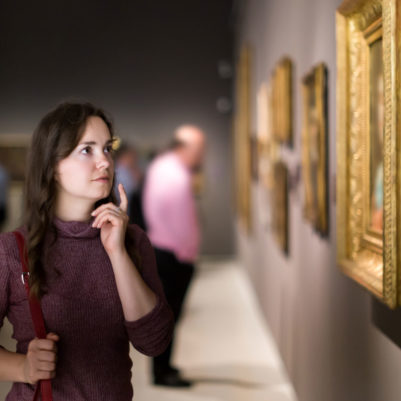The art of gallery lighting – a guide to lighting your gallery or museum
A fine balance
The way that visitors to galleries and museums engage and enjoy their experience is heavily influenced by the design and quality of the lighting.
Lighting has an effect from the moment the visitor first arrives at the gallery or museum exterior, through their journey in the curated space to the facilities, refreshments, gift shops and exit.
There is a fine balance to be struck between the widely differing requirements for illumination and the need to protect and preserve exhibits, as well as the conservation of energy and environmental impacts.


Well designed lighting is part of the drama of the gallery or museum narrative and at its best can reflect and change the mood of the room spaces. It is deployed to focus the eye of the visitor on the qualities of the exhibits and help to point the way.
All this underlines the need to work closely with an experienced lighting designer and map out exactly what is required, where the priorities sit and how to provide a responsive design that effectively manages changing displays in the spaces.
Light and shade
The way light and dark is contrasted in the gallery or museum space heightens the drama and engagement for visitors. Sensitively designed lighting will bring out the best qualities of exhibits, emphasising shape and colour of the paintings, sculptures and artefacts. For example, using narrow beams on art works in a darkened area will effectively guide the view of visitors to them. The most effective contrast ratio in a gallery is conventionally 2 to 1 while in a museum this can be pushed to 6 to 1.
Let’s talk beam angles
Galleries and museums will deploy a wide range of beam diameters to best match the proportions and mountings of the greatly varying artworks. For example, narrow spots give high intensity light over greater distances and have a beam angle of less than 10 degrees, while spotlights with a 10 to 20 degree beam angle are very effective in lighting 3D objects.
Effective use of highlighting can bring out the qualities of exhibits in the most dramatic way and a combination of higher and lower intensity point light sources will illuminate the surfaces artworks as well as the texture, colour and shape. And by minimising the light spill on to walls, artefacts can be framed to maximum effect and stand out as points of attention while larger displays can work most effectively when there is a uniform wall washing, which provides a more contemplative ambience.
In these environments, it’s important to ensure that there is no reflective glare or shadow-cast by visitors.
Lamps with wide angles arranged so that the beams criss-cross along the length of the wall space will provide uniform light distribution and a sense of spaciousness, encouraging visitors to pause, step back and reflect on the art works. Flood lights with beam angles of 25-35 degrees and wide floods with a beam angle of more than 45 degrees are ideal for creating uniform light across large areas.
Similarly, to avoid visitor shadows on 3D objects like sculptures, it’s important to have narrow-beam luminaires positioned at angles of 30 degrees with a range of light intensities to ensure that the exceptional qualities of the exhibit are illuminated.
Galleries and museums can also add playfulness and more drama by using gobo structured lenses to project patterns and images onto 2D or 3D surfaces. And framed lenses can also be used when a sharp-edged beam is required to effectively lift a 2D object from the wall and make it appear that it is lit from within rather than externally.


Dim but smart
The use of group dimming through DALI is also very effective in helping to create a quieter mood and entice the viewer to move closer to an object while individual DALI dimming will provide an intense focus on an artwork while also providing contrast and depth. Through dimming, low levels of contrast will create a lively space that is enticing for visitors while higher contrasts add theatre and act to direct them to key areas.
Good lighting design in galleries and museums will focus on optimal colour rendering to ensure that the exhibits appear as natural as possible and the Colour Rendering Index (Ra) is used to provide a measure of the rendering ability of any light source. While a CRI of 100 is considered the best, luminaires with a CRI of >90 will ensure that the colours appear vivid and natural and the reds in particular are vibrant.
The colour of light
The way that rooms and exhibits appear to visitors is also governed by the colour temperature of the light sources, measured in Kelvin (K) and this has a significant effect on mood as well as appearance. The colour temperature indicates a warm or cooler light so lamps that emit a cooler colour temperature of 4000K and above will make the exhibit appear more defined and sharp while at the other end of the scale, a warm 1600K light will provide the tranquil illumination seen from candlelight.
And there are now colour tuneable LEDs that can be dimmed from 3000K to 1600K, so offering gallery owners and museum curators the facility to move along a range from midday light to evening light, with no loss of light quality or negative effect on beam angles, for example.
Daylight management
Harnessing daylight is important in gallery and museum spaces in that it helps to maintain a connection to the world outside and also provides a sense of comfort for visitors. It is also excellent quality of light with optimal colour-rendering properties. But it does need to be managed carefully.
The fluctuating nature of natural light in a gallery or museum setting means that a good lighting design will make the best use of ambient natural light at peak times with a seamless move to artificial light as illumination levels drop.
At the same time, the harmful effects of UV radiation from direct sunlight on many gallery and museum artefacts are well documented and the destructive effects are seen in a combination of the light intensity and how long the artefact is exposed. It is clear that direct sunlight needs to be effectively shielded to avoid damage to artworks.
It’s also very important to control the amount of time that objects are exposed to light and this should be monitored and managed accordingly.
No brainer
The light of choice now for galleries and museums is overwhelmingly LED as the best brands now provide excellent quality of light, top CRI and range of colour temperatures with dimming and other control facility. Crucially, LEDs emit no damaging UV or IR radiation and produce far less heat than any other options.
LEDs are also the favoured choice because they are exceptionally energy-efficient, using up to 90% less electricity than traditional counterparts, which also has a beneficial effect on the environment through far lower carbon emissions. And they have a very long working life of up to 50,000 hours, which means less replacement and maintenance costs.
LED in Numbers
LED Bulbs: Working life
50,000 hours
Less replacement & maintenance costs
LED Bulbs: Energy saving up to
90%
Lower electricity bills & reduced carbon footprint